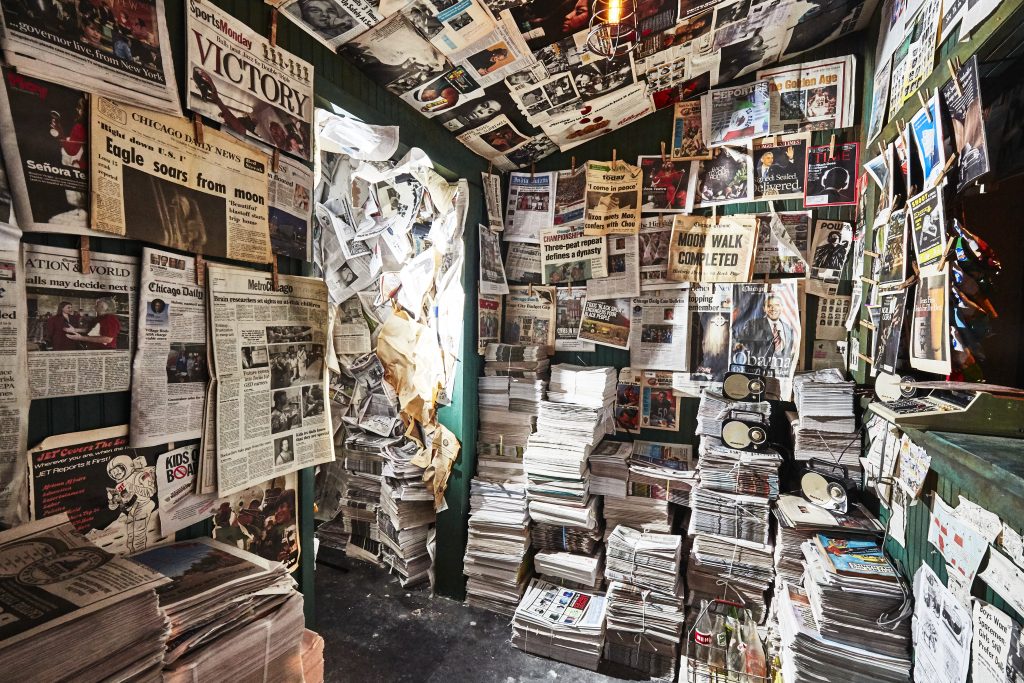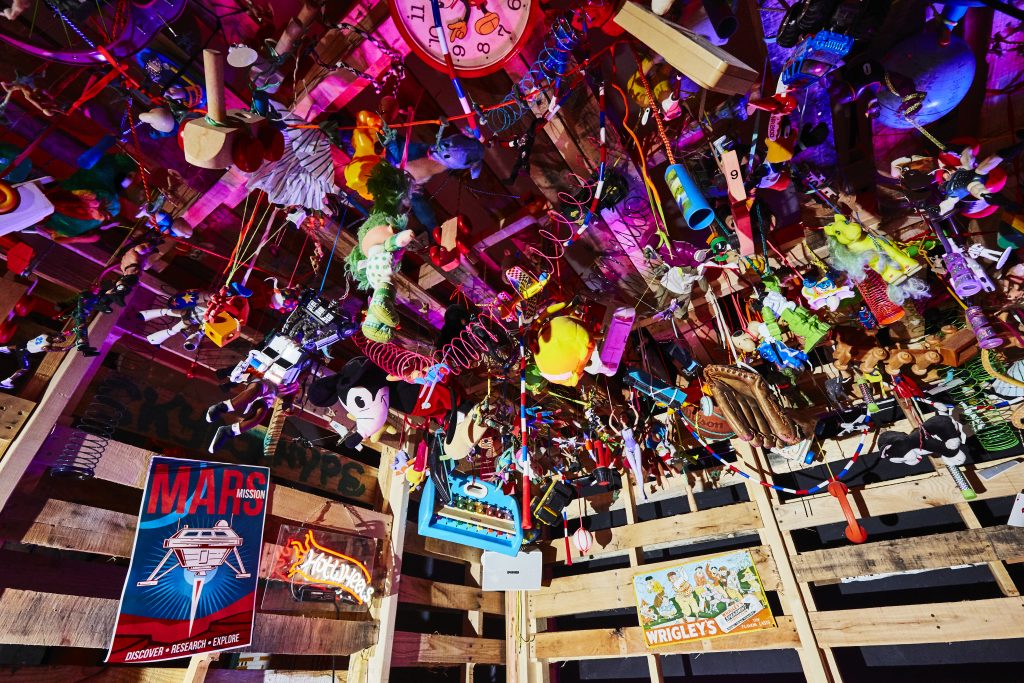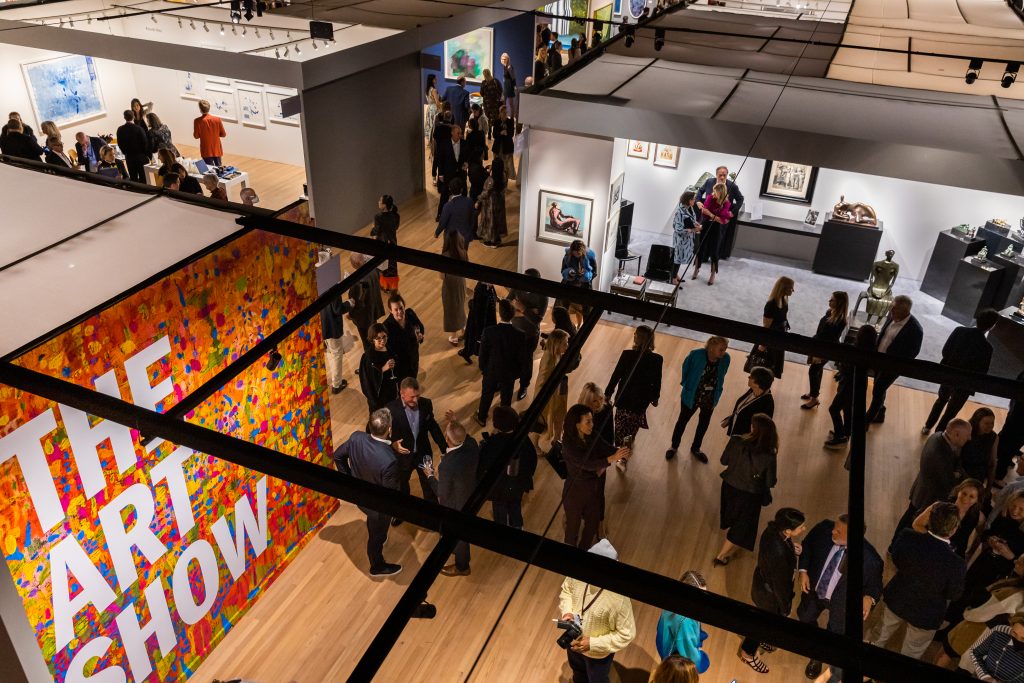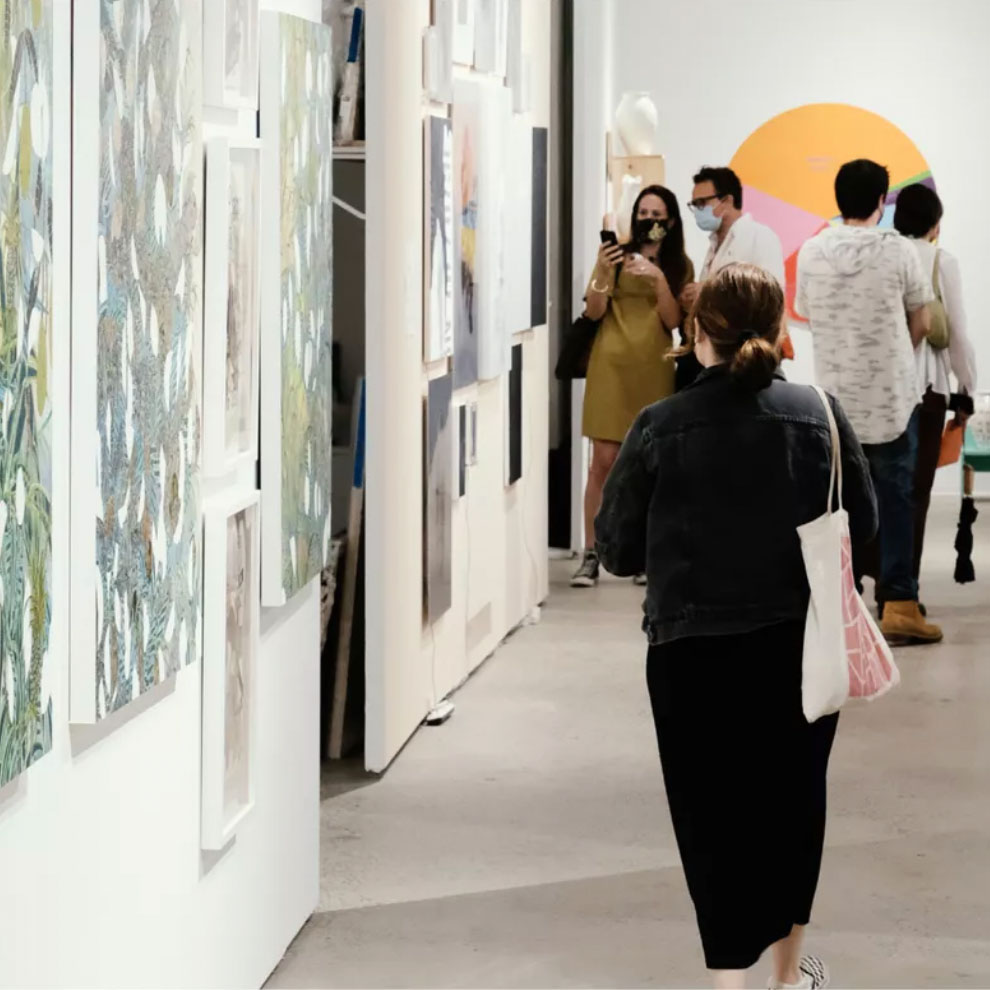Interview: Artist Hebru Brantley on the Opening of Chicago’s Nevermore Park
Part art exhibition, part theater, the project aims to represent and attract people who rarely visit galleries

Hebru Brantley‘s work spans various mediums. His iconographic style centers on two characters: Flyboy and Lil Mama. He’ll plaster them as massive murals on the sides of buildings, paint them on canvas, collaborate on sculptures of them, and more. In the sub-10 years of their existence, Flyboy and Lil Mama have gone from imaginary friends of his to internationally recognized heroes.

Brantley has also done directing work, collaborated with media conglomerates, hip-hop artists, big brands and storied institutions. In an effort to centralize his work, and bring Chicago something new, Brantley will open Nevermore Park on 24 October. The 6,000-square-foot hybrid gallery space focuses on a fictional neighborhood on Chicago’s south side, where Flyboy and Lil Mama reside. It’s far more than an installation and Brantley hopes this will grow into an institution of its own, representing people of color who’ve otherwise not seen themselves in superhero comics, cinema or art galleries. We spoke with the multi-dimensional artist ahead of Nevermore Park’s grand opening to discuss comics, art, origin stories, Chicago and more.

For anyone who isn’t familiar with Nevermore Park, what is it?
It’s an interactive, sort of immersive experience. Exhibition art meeting theater, basically. The goal was to open not only my fans, but also a wider audience up to the world of Flyboy and these characters and this creation. I spent a year-plus developing a narrative around characters that never had one. [Originally] it was more using them as a way of expressing commentary in the artwork. And then giving them a real history and a real future.
While the comic was being developed, and these other things were being worked on, the artist in me wanted to do an installation that leads into a preview of all of the things to come. That’s sort of what this represents. The goal would be to have it be something that is constant, that’s sort of an institution in Chicago, that continues to evolve.

But there’s an intention to it. It’s not just meant to be there, but rather be doing something.
There’s this intersection where the comic world and the art world have this one same sort of stigma. There isn’t inclusiveness in its audience. Your average person isn’t really readily willing to engage and go to a gallery or a museum, in my opinion, because it’s like they don’t feel like they know enough or don’t know how to act. Or even that they don’t know how to respond in a space. That, “I don’t know enough about art so I wouldn’t dare go into that arena.” That same feeling is there for comics: “I don’t know these worlds, these characters.” But it shouldn’t be like that. A lot of the intention with this is to bridge those things, and make people more comfortable engaging in those spaces.
The intention is to separate that [Nevermore Park] from the high art space, so it can live and be its own thing. It’s weird. When you look at contemporary artists, and especially pop artists, they’ve created their version of a Superman or Wonder Woman, or whatever, right? But they have no attachment to that thing. But I see this as being bigger than just the art world. Bigger than just a comic book.

Are you then not only trying to draw this new audience in, but also represent them within the space?
I think there’s opportunity for that. Effectively, at its height and even now, that’s what street art did. It made it far more approachable, right? Because now it’s on your commute. It’s loud. It’s in your face as you hit this corner. Street art brought a lot of people into art in a way that they wouldn’t otherwise. Even for me, in Chicago, I’ve gotten huge opportunities based on someone engaging with one of my pieces almost accidentally. Then they’re seeking me out and they start to understand how deep it goes, but they would never come in the other way.

And these are people that don’t come in with extensive or even starter art collections. They don’t really have any. They’ve got some stuff from Target and a few posters and shit that they like. It sometimes becomes a catalyst for them to collect and engage—all because they figured out a way to do it. And that’s all such a huge part of this installation.

For people that come to Nevermore Park without prior knowledge of you or your characters, Flyboy and Lil Mama, does the space also have to introduce and explain them? Can visitors live out their entire story within?
Yes and no. Yes, in the sense that you get to explore a bit of the characters. No, because we don’t do any future-tense storytelling within the space. It’s all sort of past experience. If you look at it in the context of a film, this is the first act of an origin story. This gives you the context. There’s a large element of revisionist history, too. The story takes place in Chicago, in a fake neighborhood called Nevermore Park, but it has connection and commonality to areas I grew up in.
It’s something Chicago desperately needs: a creative outlet. The stigma [around] Chicago is the violence, the corruption, and if I can lend to changing that conversation—that dynamic—by having things like this, making institutions in Chicago, and making these characters mascots for my city, that’d be ideal. When you think of Spider-Man, you think of New York. When you think of Rocky, you think Philadelphia. It’s these characters engaging in real places, and those places take on a whole other life.

Is there something that you want these guests to leave Nevermore Park with?
With everything I do, I obviously want you to feel something: love it or hate it. I think something that’s always really important to me is—say financially—I might not be able to give back a heavy endowment to some institution, but we can engage with younger folks. I never had a me. So a lot of this was me getting used to the roadmap, figuring this out, crashing my car, fixing it, and getting back on the road.
It’s to be a clearer map, with real clear points of entry. Someone could say, “Oh, he did it like this? Yeah, but I’m going to tweak it and do it my way.” But, it’s about seeing that the creative is a real thing. You don’t have to give up. Also, black creatives in the popular space are so few and far between. When I was younger, this shit was far from being what’s cool. You got talked about, you got beat up, you got challenged for wanting to be the creative type—which is just insane. I feel like it’s drastically changed to where the artists are the cool kids now. The nerds are the cool kids. This is a celebration of that. It’s pushing the agenda and telling these kids, “Don’t fucking stop. Just create. That’s it. That’s all.” It’s a way for me to give back to Chicago and the art world at large.

Today, for instance, you can feel however you wish to about Virgil Abloh, but he’s also proof it can happen.
It’s like [Barack] Obama, right? When I was a kid, if I said, “I want to be the next President,” they’d be like, “You’re black, get out of here, no way. It just doesn’t happen.” But it’s happened now. You can look at that, and aspire to be different, greater than, whatever. But it’s that whole thing; it’s the Virgil. It’s kids going from having no idea or no general sense of design to really hyper-focusing on it because they see it’s possible. Not only did this guy, Virgil, not only do a thing, but he ran a thing that traditionally was not about people of color, right? That was never their audience. That was never the intention. And now you have a black hip-hop kid from Illinois running the whole shop and changing culture.
It’s not just about the paintings. It’s never been just about that. I want to tell stories.
Have his accomplishments resonated with you then? For instance, now you have Nevermore Park. Is it now about what you can do next?
This, for me, has always been the start, the beginning of the storm. It’s not just about the paintings. It’s never been just about that. I want to tell stories. This has been years and years and years in the making. And I totally subscribe to the notion of being a Jack of All, but a Master of None. I think that’s the space I choose to really live in, and that’s the space that is most intriguing and appealing to me. We have examples of that now, where before it was kind of scarce.

For many, there’s a significance to seeing the worlds of Flyboy and Lil Mama be built within their lifetime. Is that important to you, too?
For me, it all starts with iconography. It’s the identifiable thing: Basquiat’s crown, Kaws’ Xs, Murakami’s flower, Haring’s people. It sort of starts there, and I’m a huge fan of that. And if I can affect people in that same way then great. But the moment that crystallized why I do what I do was when I had just gotten off the lift, took a step back and was across the street in the parking lot. At a bus stop, there was this kid—a little boy—maybe he was walking home, and caught the image [the Flyboy mural]. He stepped back a little further and, he honestly could’ve been hit by a car, but he didn’t take his eyes off that wall. And again, it wasn’t even finished, but he stopped dead in his tracks and engaged with it. And I knew this kid had never seen himself as a hero or out in the world—and this predates Black Panther and all of that. That was a big moment. I don’t know what that means for him, where it’ll go or take him, but in that moment it grabbed him and spoke to him.

Tickets are available now on Nevermore Park’s website. The first available time-slot will be for the 24 October at 12:30PM CT.
Images by Amy Lombard












